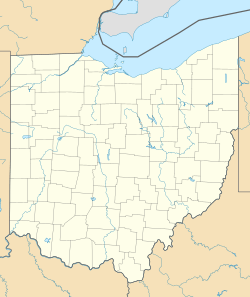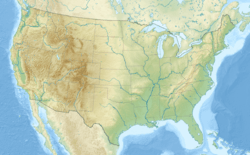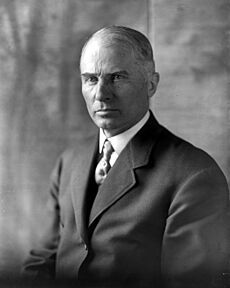Willard, Ohio facts for kids
Quick facts for kids
Willard, Ohio
|
|
|---|---|
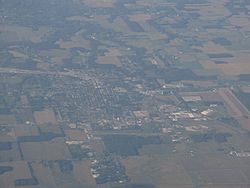
Aerial view of Willard, September 2012
|
|
| Etymology: Daniel Willard | |
| Nickname(s):
"The City of Blossoms"
|
|
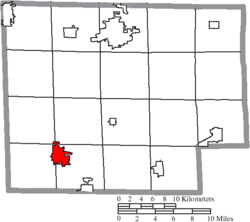
Location of Willard in Huron County
|
|
| Country | United States |
| State | Ohio |
| County | Huron |
| Town founded | 1874 (as Chicago) |
| Town incorporated | 1882 (as Chicago Junction) |
| City incorporated | 1960 (as Willard) |
| Government | |
| • Type | Council/Manager |
| Area | |
| • Total | 3.60 sq mi (9.33 km2) |
| • Land | 3.58 sq mi (9.27 km2) |
| • Water | 0.02 sq mi (0.06 km2) |
| Elevation | 938 ft (286 m) |
| Population
(2020)
|
|
| • Total | 6,197 |
| • Density | 1,731.01/sq mi (668.27/km2) |
| Time zone | UTC-5 (Eastern (EST)) |
| • Summer (DST) | UTC-4 (EDT) |
| ZIP codes |
44888, 44890
|
| Area code(s) | 419 |
| FIPS code | 39-85232 |
| GNIS feature ID | 1086362 |
Willard is a city in southwestern Huron County, Ohio, United States. It is about 14 miles (22.5 km) southwest of Norwalk. In 2020, the city had a population of 6,197 people.
Contents
History of Willard's Name
Willard was first called Chicago. This name came from a railroad junction. The Baltimore and Ohio Railroad had lines meeting there. One line went to Sandusky, and another went west to Chicago.
People often confused this small town with the big city of Chicago, Illinois. So, the town changed its name to Chicago Junction. However, the word "junction" was too long for the train station signs. This meant the confusion continued.
In 1917, the town finally changed its name again. They chose Willard to honor Daniel Willard. He was the president of the B&O railroad at that time. Willard officially became a city in 1960.
Geography and Location
Willard is a city with a total area of about 3.57 square miles (9.25 square kilometers). Most of this area, about 3.55 square miles (9.19 square kilometers), is land. Only a small part, about 0.02 square miles (0.05 square kilometers), is water.
South of Willard, you can find the small communities of Celeryville and New Haven. To the north, there is a planned community called Holiday Lakes.
Population Changes Over Time
| Historical population | |||
|---|---|---|---|
| Census | Pop. | %± | |
| 1880 | 662 | — | |
| 1890 | 1,299 | 96.2% | |
| 1900 | 2,348 | 80.8% | |
| 1910 | 2,950 | 25.6% | |
| 1920 | 3,889 | 31.8% | |
| 1930 | 4,514 | 16.1% | |
| 1940 | 4,261 | −5.6% | |
| 1950 | 4,744 | 11.3% | |
| 1960 | 5,457 | 15.0% | |
| 1970 | 5,510 | 1.0% | |
| 1980 | 5,720 | 3.8% | |
| 1990 | 6,210 | 8.6% | |
| 2000 | 6,806 | 9.6% | |
| 2010 | 6,236 | −8.4% | |
| 2020 | 6,197 | −0.6% | |
| 2021 (est.) | 6,183 | −0.8% | |
| Sources: | |||
Willard's Population in 2010
In 2010, Willard had 6,236 residents. There were 2,365 households in the city. The population density was about 1,756 people per square mile (678 people per square kilometer).
Most of the people in Willard were White (90.0%). About 18.9% of the population identified as Hispanic or Latino. The average age in the city was 34.6 years old. About 28.7% of residents were under 18 years old.
Local Economy
Willard is home to several important businesses. The CSX Transportation company has a large rail yard here. Other companies include Stanley Black & Decker and LSC Communications. You can also find a Pepperidge Farm factory and Mercy Hospital of Willard.
The area around Willard has a lot of farmland. Farmers grow crops like soybeans, wheat, onions, radishes, lettuce, and sweet corn. Well-known farms in the area include Wiers and Buurma farms.
Education in Willard
Students in Willard attend schools operated by Willard City Schools. The main high school is Willard High School. High school students can also choose to go to Pioneer Career and Technology Center. This center is in Shelby, Ohio, and teaches trade skills.
The city also has a public library. It is called the Willard Memorial Library.
Famous People from Willard
- Charlie Frye, a former NFL quarterback
- Harry Jump, an Ohio State Senator
- Pam Postema, the first woman to umpire a Major League Baseball spring training game
See also
 In Spanish: Willard (Ohio) para niños
In Spanish: Willard (Ohio) para niños


